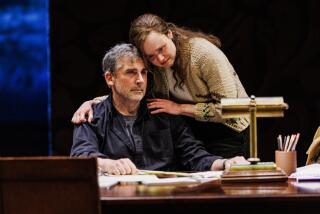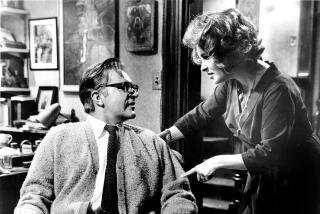Pair of ‘Albee’s People’ Suffers From a Certain Disjointedness
- Share via
SAN DIEGO — Greatest hits collections have become a staple of the music industry. They allow recording companies to get added mileage--and money--out of an artist’s output, without depending on new material.
Such a concept, however, rarely works in theater. And it doesn’t with “Albee’s People,” a two-part presentation--”Albee’s Men” and “Albee’s Women,” on separate nights--that the Old Globe is offering as its season opener. Edward Albee’s immense writing talents notwithstanding, watching a compilation of his characterizations is like seeing a sequence of very good auditions.
Albee, of course, has been a major force in U.S. and international theater for four decades, with a shelf full of awards, including Pulitzers and Tonys. From his prodigious oeuvre, director Glyn O’Malley, a longtime Albee associate, has carefully chosen examples of the playwright’s ability to delineate his personae through incisive and unerring dialogue. The segments, separated by blackouts, each provide a mini-drama and a chance for actors to tackle some of the stage’s most challenging roles.
The problem with that, as with all such aggregations, is that mini-dramas usually prove more frustrating than fulfilling. The characters become involving, then give way to a new scene, and the process has to begin again. Whether the scene is from Albee’s most familiar work, “Who’s Afraid of Virginia Woolf?,” or from the obscure “The Man Who Had Three Arms,” it leaves a feeling of insufficiency, of wanting to know more about the principals and their circumstances.
Then there’s the matter of rhythm and pacing. Good plays have a correct ebb and flow, building to a strong climax. Here it’s a start-stop disjointedness, with no buildup. For the actors, the format requires that instead of fleshing out their roles, they give instant credibility to varied types. And if the types aren’t that varied--sometimes the case in “Women”--the challenge is nearly insurmountable.
Accordingly, it’s not surprising that the “Albee’s People” performances ranged widely. It’s also not surprising that Richard Easton, playing the older-man roles, was consistently superb. Allen Williams, middle-aged man, brought excellent liveliness to the “Three Arms” lecturer, the most humorous of O’Malley’s selections. Brian Hutchison, young man, had his best moment as the tormented priest in “Tiny Alice.”
Among the women, Carol Mayo Jenkins, middle-aged woman, generally captured the right sardonic tone for her characters, and Lois Markle did best with the defiant feistiness of her older women. Jennifer Erin Roberts was uneven as the younger women.
Robin Sanford Roberts’ set is elegant and efficient, a patterned hardwood floor and minimal furnishings. Tucked away in a corner cabinet drawer are the props so necessary for so many scenes--liquor and glasses. Jeff Ladman’s sound stays properly subtle, becoming prominent only in the muffled laughter of “Tiny Alice.” Austin Sanderson’s costumes generally help by quickly establishing the characters, although more defining for the men than the women. Likewise, Phillip Monat’s lighting design provides much more variety in “Men,” vividly aiding Easton’s “Seascape” depiction of submerging himself.
*
* “Albee’s People,” Cassius Carter Centre Stage, Balboa Park, San Diego, consists of separate offerings, “Albee’s Women” and “Albee’s Men.” The former runs Wednesdays and Fridays at 8 p.m., Saturdays at 2 and 8 p.m.; the latter Tuesdays and Thursdays at 8 p.m., Sundays at 2 and 7 p.m., Ends March 21. $23-$39. (619) 239-2255. Running time: “Women”: 2 hours; “Men”: 2 hours, 20 minutes.
More to Read
The biggest entertainment stories
Get our big stories about Hollywood, film, television, music, arts, culture and more right in your inbox as soon as they publish.
You may occasionally receive promotional content from the Los Angeles Times.










